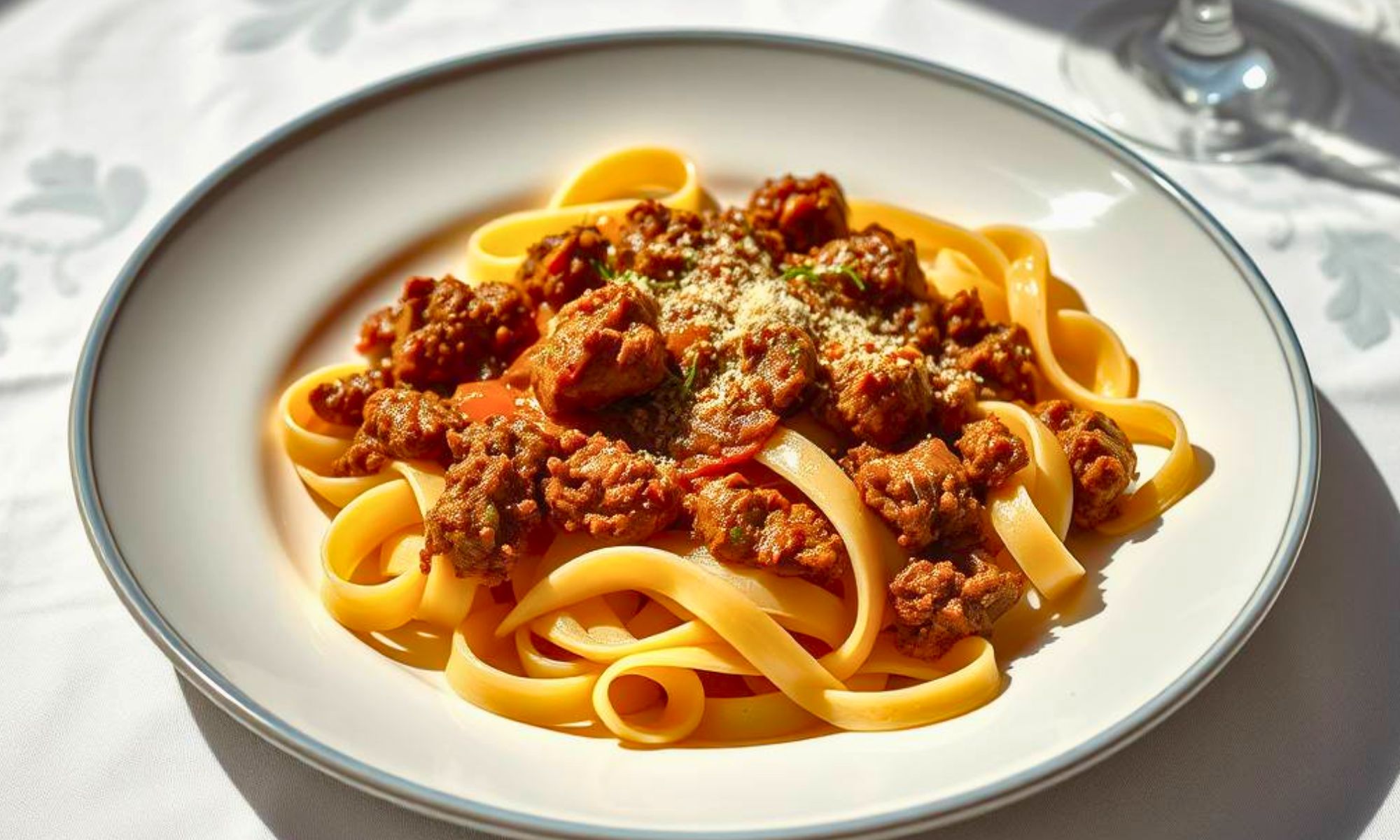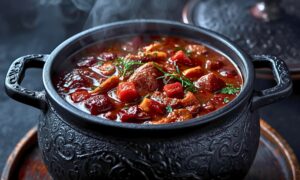The pasta water was already boiling when I realized I didn’t want another red sauce dinner. It wasn’t about being bored, it was more about chasing something creamy, savory, and quietly bold. That’s exactly how this White Bolognese Sauce came to life, a crave worthy shift from the usual, delivering deep comfort without the weight of tradition.
I had ground chicken, a few shallots, some white wine, and a nearly forgotten tub of ricotta. No master plan, just a cool night, a half stocked fridge, and a craving for something that felt like a hug without leaning into the usual tomato comfort zone. I started building it slowly. Shallots hit the butter with a soft hiss. Garlic followed. The meat browned gently while the wine lifted everything off the bottom of the pan like a secret being revealed.
As it simmered, I folded in grated parmesan, cream, and a quick burst of lemon zest. The sauce didn’t shout; it settled in. Silky, savory, with just enough brightness to keep it from feeling heavy. Ladled over pasta and scattered with herbs, it became the kind of meal that earns a spot in the mental rotation, not because it’s fancy, but because it just works.
This Zesty White Bolognese is that recipe. No shortcuts, no fluff, just clear instructions, flexible ingredients, and small, thoughtful moves that make it shine. I’ll walk you through it all, step by step, with tips for substitutions, make ahead options, and ways to make it your own. Once it hits your table, you’ll know why I stopped reaching for the red sauce.
Why Master White Bolognese Sauce Techniques
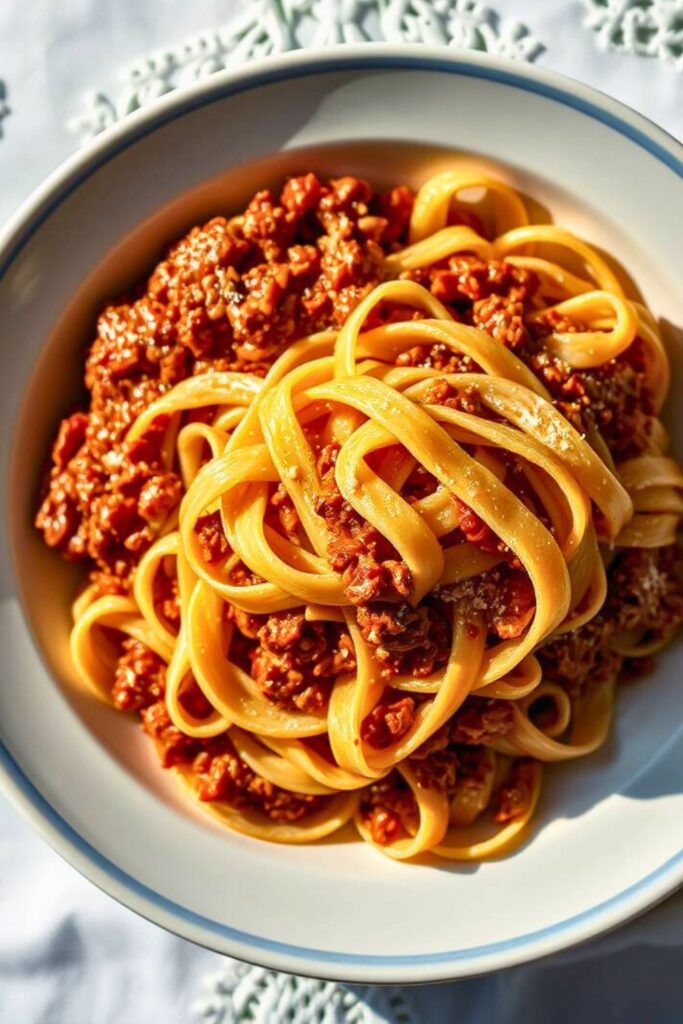
Traditional ragu bianco from Emilia Romagna predates the tomato version. It’s more refined, more elegant, and honestly? Way more impressive when you’re showing off cooking skills.
The technique demands patience, not complexity. Every minute of slow simmering pays off when you taste results that’ll make you question every pasta sauce you’ve ever made.
This white bolognese sauce lets beef and pork develop deep, caramelized flavors. Wine adds brightness. Milk provides velvety richness. Together, they create something that transforms simple pasta into restaurant worthy luxury.
Essential Ingredients for Perfect White Bolognese Sauce
Your Flavor Arsenal
Here’s your lineup, ordered exactly how you’ll use them:
- 2 tablespoons olive oil
- 4 slices thick cut pancetta, diced small
- 1 medium onion, finely chopped
- 1 carrot, finely diced
- 1 celery stalk, finely diced
- 3 garlic cloves, minced
- 1 pound ground beef (80/20 blend)
- ½ pound ground pork
- 1 cup dry white wine
- 2 cups whole milk
- 1 cup beef stock
- 2 bay leaves
- Fresh thyme sprigs
- Salt and white pepper
- ½ pound fresh pappardelle
- Parmigiano Reggiano for serving
Smart Substitutions That Actually Work
No pancetta? Use thick bacon, but blanch it first to remove excess smokiness. Skip pork entirely? Bump beef to 1.5 pounds and add extra wine.
Lactose problems? Try lactose free milk or heavy cream thinned with stock. Won’t be traditional, but still delicious.
No white wine? Grab Pinot Grigio you’d actually drink. Never use cooking wine, it’ll ruin your white bolognese sauce completely.
Ask your butcher to grind beef chuck and pork shoulder fresh. Pre ground works fine, but fresh ground gives incredible texture control. Fat content matters more than you think, lean meat creates flat tasting sauce.
Step by Step White Bolognese Sauce Mastery
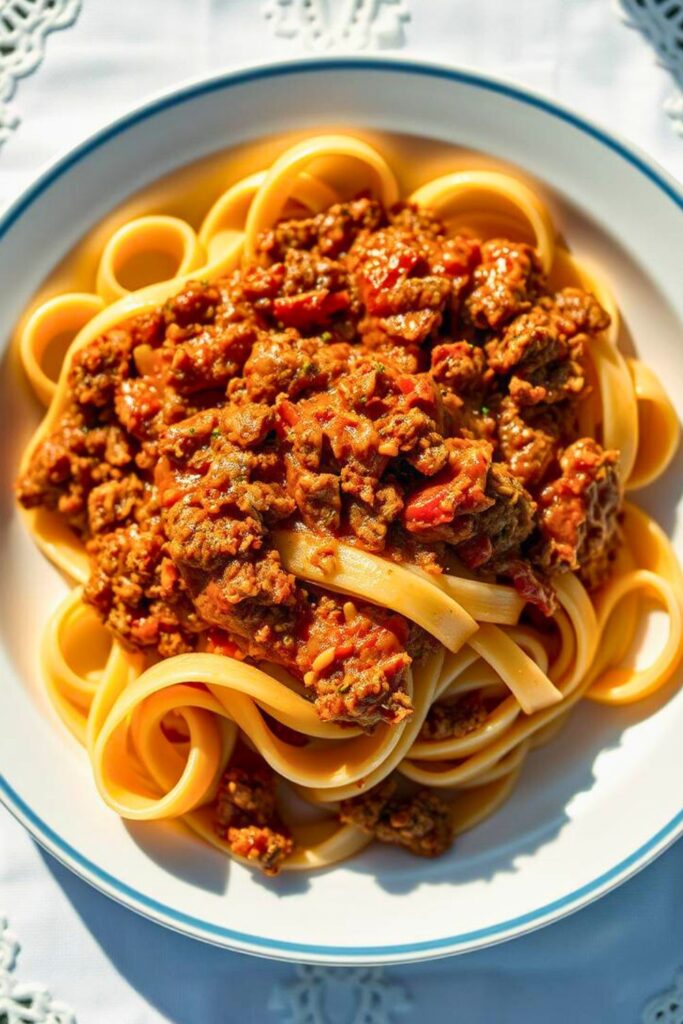
Building Your Flavor Foundation
Start pancetta in a cold, heavy bottomed pan. This matters, you want fat rendering slowly and evenly. Use medium heat, no rushing. Listen for gentle sizzling, not aggressive popping.
Once pancetta crisps and fat renders, add olive oil and your soffritto trinity: onion, carrot, celery. Cook vegetables until softened and lightly golden, about 8 minutes. Don’t brown hard, you want sweetness, not bitterness.
The smell tells you when it’s ready: sweet, aromatic, pure comfort food heaven.
The Meat Magic Moment
Add minced garlic for 30 seconds until fragrant. Then comes meat, and here’s where people mess up: don’t break it up immediately. Let it sear properly first.
After 3 minutes, start breaking up with wooden spoon. You want texture, not baby food consistency. Season generously with salt and white pepper as you go.
Wine and Time Transform Everything
Add white wine and let it bubble enthusiastically. Cook off harsh alcohol but keep complex flavors. This takes 5 minutes of active simmering.
Pour milk slowly, stirring constantly. Now patience becomes your best friend. Simmer, don’t boil, for at least 2 hours. I prefer 3 when time allows.
Add bay leaves and thyme now. Keep heat low enough for occasional bubbles only. Too hot curdles milk. Too cool prevents proper depth development.
The Long Simmer Secrets
Every 20 minutes, stir gently and add stock if needed. Your white bolognese sauce should coat spoon backs when ready, with milk reduced to creamy, ivory richness.
Taste and adjust seasoning 30 minutes before finishing. Flavors concentrate as liquid reduces, so start light on salt.
The Science Behind Luscious White Bolognese Sauce Perfection
Long simmering breaks down meat proteins slowly, creating incredible depth. Milk proteins interact with wine’s acidity to create velvety texture impossible to achieve otherwise.
Maillard reactions happen continuously at low heat. Each ingredient builds on others: rendered pork fat carries flavors, wine adds brightness, milk provides richness and body.
This technique dates to medieval times when tomatoes weren’t available in Italy. Cooks relied on dairy, wine, and time to create nutritious, delicious sauces. They understood something we’ve forgotten: slow cooking transforms simple ingredients into extraordinary results.
The chemistry gets fascinating here. When you brown meat properly, you’re creating hundreds of flavor compounds through the Maillard reaction. These compounds are fat soluble, which means they dissolve beautifully into the rendered pork fat and olive oil. As the sauce simmers, these flavors concentrate and meld.
Wine contributes more than just alcohol and acidity. White wine contains natural enzymes and tannins that help break down tough meat fibers while adding complexity. The alcohol evaporates, but leaves behind esters and aldehydes that create those subtle fruity, floral notes you taste in the finished sauce.
Milk’s role is equally complex. The proteins and natural sugars caramelize slowly during the long simmer, creating sweetness and richness. Lactose breaks down into simpler sugars that brown beautifully, giving your white bolognese sauce that characteristic ivory color and subtle sweetness that balances the wine’s acidity.
Temperature control becomes critical because milk proteins denature around 180°F. Keep it lower, and they stay smooth and creamy. Go higher, and you get grainy, broken sauce that no amount of whisking can fix.
Heavy bottomed Dutch ovens distribute heat evenly and prevent hot spots that break sauces. Thin pans create temperature fluctuations that ruin hours of work instantly. Cast iron works beautifully too, but requires more attention since it holds heat so well.
Regional Variations of White Bolognese Sauce
Different Italian regions put their own spin on white bolognese sauce, and understanding these variations gives you permission to experiment once you’ve mastered the basics.
In Tuscany, they often add a splash of cream at the very end for extra richness. Umbrian cooks sometimes include finely chopped mushrooms with the soffritto, creating earthy depth that’s absolutely divine. The Veneto region favors adding a touch of nutmeg, just a whisper, which enhances the milk’s natural sweetness.
Some northern Italian recipes call for veal instead of beef, creating an even more delicate flavor profile. If you can find good ground veal, try substituting half the beef. The texture becomes silkier, and the taste more refined.
The wine choice varies by region too. Soave from Veneto creates a cleaner, more mineral finish. Vermentino from Liguria adds subtle herbal notes. Falanghina from Campania brings slight salinity that enhances the meat flavors beautifully.
Storage and Reheating White Bolognese Sauce
Proper storage keeps your white bolognese sauce tasting fresh for days. Cool it completely before refrigerating, hot sauce creates condensation that waters down flavors. Store in glass containers rather than plastic, which absorbs flavors and odors.
When reheating, add liquid gradually. Start with a tablespoon of milk or stock per cup of sauce. Heat gently over low flame, stirring frequently. Never microwave, the uneven heating breaks the emulsion and creates greasy, separated sauce.
Frozen white bolognese sauce keeps for three months. Thaw overnight in refrigerator, then reheat as above. The texture might seem slightly grainy at first, but gentle stirring brings it back together beautifully.
Troubleshooting Common White Bolognese Sauce Problems
Sauce too thick? Add warm stock gradually until you reach desired consistency. Too thin? Simmer uncovered for 15-20 minutes, stirring occasionally.
Grainy texture usually means the heat was too high during simmering. Next time, keep it lower. For current batch, try blending a cup smooth and stirring it back in.
Bland flavor often comes from underseasoning or insufficient browning. Taste and adjust salt carefully, remember, Parmigiano Reggiano adds saltiness too. If flavors seem flat, a splash of lemon juice can brighten everything up.
Serving White Bolognese Sauce Like a Pro
Restaurant Quality Presentation
Fresh pasta is non negotiable. Rich white bolognese sauce stands up to thick ribbons like pappardelle or tagliatelle. Toss pasta with pasta water first, this helps sauce cling properly.
Warm your serving bowls. Cold plates cool sauce and make it look greasy instead of glossy. One minute in low oven works perfectly.
Finish each serving with freshly grated Parmigiano Reggiano and good olive oil drizzle. White pepper adds subtle heat without competing with delicate flavors.
Perfect Pairing Combinations
This white bolognese sauce begs for crisp white wine, the same Pinot Grigio you cooked with, or Soave or Vermentino. Acidity cuts through richness beautifully.
Keep sides simple. Bitter green salad with lemon vinaigrette provides perfect contrast. Roasted asparagus or sautéed spinach work wonderfully too.
Your Luscious White Bolognese Sauce Success Story
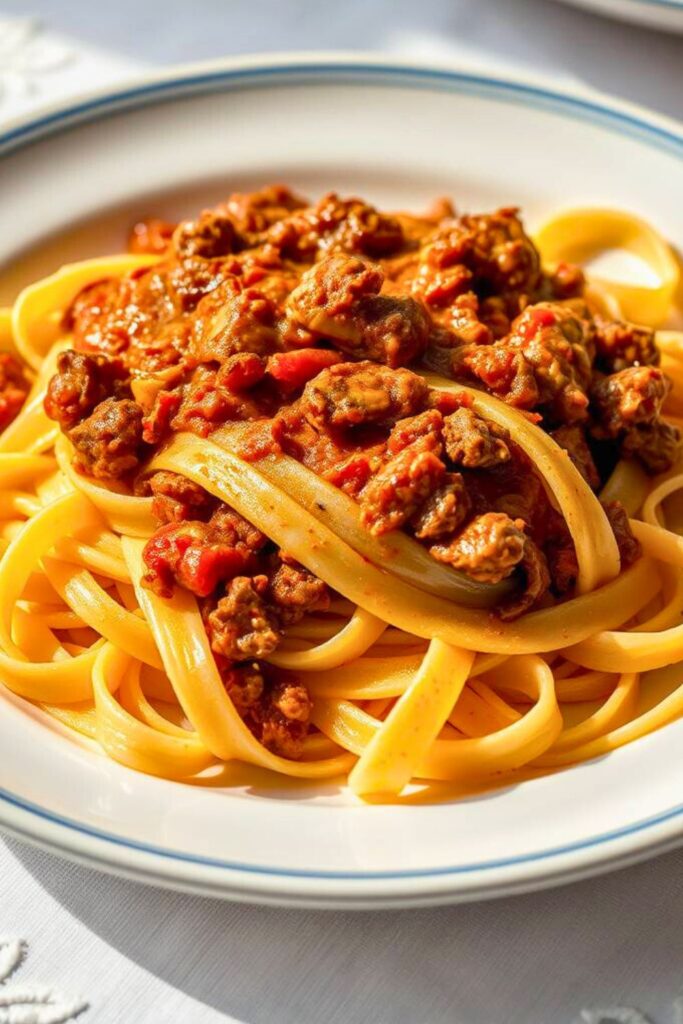
Making authentic white bolognese sauce isn’t just following recipes, it’s understanding how time and patience transform simple ingredients into magic. This isn’t weeknight cooking; it’s weekend luxury rewarding you with even better leftovers.
Beauty lies in restraint. No aggressive herbs, no overwhelming spices, just perfectly balanced flavors letting each ingredient shine. It’s sophisticated comfort food proving Italian cooking isn’t about shortcuts, it’s about respecting tradition and quality ingredients.
Once you master this white bolognese sauce technique, you’ll make it repeatedly. It freezes beautifully, doubles easily, and impresses everyone who tastes it. Most importantly, it connects you to centuries of Italian cooking tradition deliciously.
The beauty of mastering white bolognese sauce lies in its versatility. Use it as a base for lasagna, layer it with béchamel and Parmigiano for something extraordinary. Toss it with gnocchi for pillowy perfection. Even serve it over polenta for a completely different but equally satisfying experience.
This sauce teaches patience in our instant gratification world. There’s something meditative about the slow stirring, the gentle bubbling, the gradual transformation of simple ingredients into something magical. It’s cooking as therapy, as art, as connection to generations of Italian cooks who understood that the best things can’t be rushed.
Professional chefs charge premium prices for dishes featuring white bolognese sauce because they know most home cooks won’t invest the time. But you’re different. You understand that real cooking, the kind that nourishes both body and soul, requires dedication. That three hour investment returns dividends in flavor, satisfaction, and the pure joy of creating something extraordinary from scratch.
Frequently Asked Questions about White Bolognese Sauce
Can I make white bolognese sauce ahead of time?
Absolutely, and it actually improves as it rests. You can make it up to 3 days in advance and store it covered in the refrigerator. The flavors meld and deepen beautifully, creating an even richer taste. When you’re ready to serve, reheat it gently over low heat, adding a splash of stock or milk if it has thickened too much. It also freezes well for up to 3 months, just thaw it overnight in the fridge before reheating for best texture and flavor.
What if my white bolognese sauce breaks or curdles?
Don’t panic, this happens when heat’s too high or you added milk too quickly. Remove from heat immediately and whisk in cold milk. If really broken, blend one cup smooth and stir back in. Prevention’s easier: keep heat low and steady.
Can I use different pasta with white bolognese sauce?
Fresh egg pasta works best because the sauce is rich and delicate. Pappardelle, tagliatelle, or fresh gnocchi are perfect. Avoid thin pastas like angel hair, they can’t support sauce properly. If using dried pasta, choose ridged varieties like rigatoni that hold creamy goodness.
How do I know when white bolognese sauce is properly reduced?
Sauce is ready when it coats wooden spoon backs and you can draw lines through it that hold briefly. It should look creamy and ivory colored, not watery or separated. Taste wise, wine should be mellow, all flavors harmonious. This takes 2-3 hours of gentle simmering.
What’s the difference between white bolognese sauce and regular meat sauce?
Traditional bolognese uses tomatoes and cooks for hours developing complex flavors. White bolognese sauce skips tomatoes entirely, relying on milk, wine, and slow cooking for richness. It’s more delicate, sophisticated, and actually older than tomato versions. Technique requires more attention since there’s no tomato acidity balancing richness, but results are incredibly elegant.

Swiftly Captions by Tina Smith — Quick, flavorful food recipes made simple, bringing fresh inspiration to your kitchen every day
